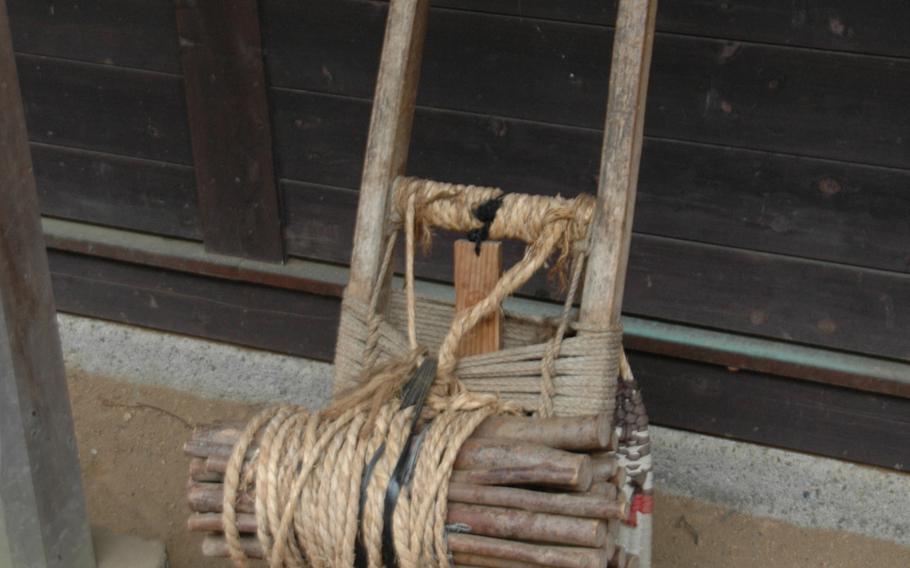
Ancient Japanese used to use backpacks like this to transport goods along the Tokaido Highway, a stone paved road that once linked the shogun's capital Edo (now Tokyo) with the imperial residence in Kyoto. Hakone used to be the final checkpoint on the road before Tokyo. (Seth Robson/Stars and Stripes)
Are you off to explore Japan on the weekend? Or do you have friends in town and you’re looking for a nice outing for the day?
Consider heading to Hakone, a tourist town beside Lake Ashi in Kanagawa Prefecture that’s packed with amusements to suit almost anyone.
Hakone is part of the Fuji-Hakone-Izu National Park, about a 90-minute drive from U.S. military bases in Japan. The area features stunning views of the lake and Mount Fuji, as well as bubbling mud and steam coming out of the ground. And don’t forget the onsens.
Entrepreneurs have added museums, hotels, restaurants, ferry rides, cable cars and gift shops.
It’s possible to buy a pass that will let you ride the ferries, cable cars and buses so that, if you get there by train, you still can move around with relative ease.
People with a lot of energy might enjoy hiking sections of the ancient Tokaido Highway, a stone paved road that once linked the shogun’s capital Edo (now Tokyo) with the imperial residence in Kyoto. Hakone used to be the final checkpoint on the road before Tokyo.
Hikers can visit the Amazake Chaya, a tea house that’s been serving weary travelers on the highway for 350 years. The tea house, which still features a thatched roof, dirt floors and an open indoor fire pit, serves amazke (hot, sweet rice wine) mochi (sweet rice cakes) and other snacks as well as hot tea.
The other popular meal for Hakone visitors consists of kuro tamago (black eggs), which are cooked in an onsen. Sulfur in the water causes the black color.
Reaching the shop that sells the eggs involves riding to the top of a ropeway and walking up a short track. A bag of five eggs costs 500 yen. You can join crowds of hungry tourists cracking the black eggs open on wooden benches and dipping them in salt. Legend has it that each egg consumed adds seven years to your life!
Afterwards, you can drive around the lake, ride around it in a bus or cruise across it in a “pirate ship.” The ships are actually just motor launches decorated to look like pirate ships, but it’s possible to have your photograph taken with a role player dressed as a pirate on the way across the lake.
Those who want to experience all that Hakone has to offer might be advised to book a hotel and stay for the weekend, but as a day trip, the town offers plenty of things to amuse the whole family.
robson.seth@stripes.com
Hakone, Japan Getting there By train: If you plan to spend several days in Hakone, it’s a good idea to buy the Hakone Free Pass, which provides a round-trip ticket on the express train from Shinjuku Station to Odawara or Hakone Yumoto and includes all modes of transportation in Hakone, such as the mountain tram, cable car, ropeway and boat. Many attractions also grant discounts when you present the pass.
The train trip from Shinjuku to Odawara takes 1.5 hours, and trains run about every 30 minutes. In Odawara, you transfer to the electric mountain tram, which goes to Gora. Some express trains travel all the way to Hakone Yumoto (about two hours), where you can also board the mountain tram closer to Gora.
By car: There are several ways to travel to Hakone by car, depending on where you’re coming from. Hakone is about 90 minutes by car from U.S. bases and about two hours from Tokyo. Parking is available throughout the area.
Costs The Hakone Free Pass for two days from Shinjuku, round-trip, costs 5,140 yen for adults and 1,500 yen for children.
Information In Hakone Yumoto, stop by the Yumoto Tourist Office (open daily from 9 a.m. to 5:30 p.m.). It’s staffed by English-speaking volunteers only on weekdays. You can pick up pamphlets on the Hakone area and ask directions. It’s a two-minute walk from the Hakone Yumoto Station. Take a right out of the station onto the town’s main street; the office is on the left. Website: www.hakone-english.com.